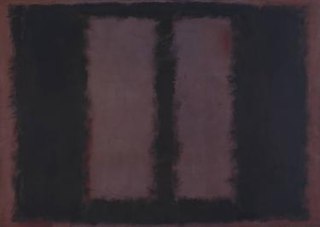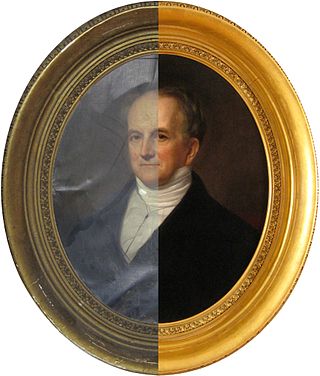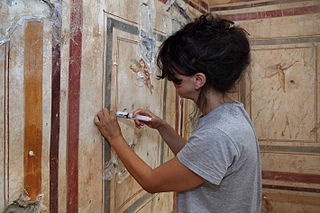
Paint is any pigmented liquid, liquefiable, or solid mastic composition that, after application to a substrate in a thin layer, converts to a solid film. It is most commonly used to protect, color, or provide texture. Paint can be made in many colors—and in many different types. Paint is typically stored, sold, and applied as a liquid, but most types dry into a solid. Most paints are either oil-based or water-based and each has distinct characteristics. For one, it is illegal in most municipalities to discard oil-based paint down household drains or sewers. Clean-up solvents are also different for water-based paint than they are for oil-based paint. Water-based paints and oil-based paints will cure differently based on the outside ambient temperature of the object being painted Usually, the object being painted must be over 10 °C (50 °F), although some manufacturers of external paints/primers claim they can be applied when temperatures are as low as 2 °C (35 °F).

Varnish is a clear transparent hard protective coating or film. It is not a stain. It usually has a yellowish shade due to the manufacturing process and materials used, but it may also be pigmented as desired. It is sold commercially in various shades.
Green chemistry, also called sustainable chemistry, is an area of chemistry and chemical engineering focused on the design of products and processes that minimize or eliminate the use and generation of hazardous substances. While environmental chemistry focuses on the effects of polluting chemicals on nature, green chemistry focuses on the environmental impact of chemistry, including lowering consumption of nonrenewable resources and technological approaches for preventing pollution.

A primer or undercoat is a preparatory coating put on materials before painting. Priming ensures better adhesion of paint to the surface, increases paint durability, and provides additional protection for the material being painted.
Polyvinylidene chloride, or polyvinylidene dichloride (PVDC), is a homopolymer of vinylidene chloride.

With respect to cultural property, conservation science is the interdisciplinary study of the conservation of art, architecture, technical art history and other cultural works through the use of scientific inquiry. General areas of research include the technology and structure of artistic and historic works. In other words, the materials and techniques from which cultural, artistic and historic objects are made.
An anti-graffiti coating is a coating that prevents graffiti paint from bonding to surfaces.

The conservation and restoration of silver objects is an activity dedicated to the preservation and protection of objects of historical and personal value made from silver. When applied to cultural heritage this activity is generally undertaken by a conservator-restorer.

Conservation and restoration of ceramic objects is a process dedicated to the preservation and protection of objects of historical and personal value made from ceramic. Typically, this activity of conservation-restoration is undertaken by a conservator-restorer, especially when dealing with an object of cultural heritage. Ceramics are created from a production of coatings of inorganic, nonmetallic materials using heating and cooling to create a glaze. These coatings are often permanent and sustainable for utilitarian and decorative purposes. The cleaning, handling, storage, and in general treatment of ceramics is consistent with that of glass because they are made of similar oxygen-rich components, such as silicates. In conservation ceramics are broken down into three groups: unfired clay, earthenware or terracotta, and stoneware and porcelain.

Iron, steel, and ferrous metals constitute a large portion of collections in museums. The conservation and restoration of iron and steel objects is an activity dedicated to the preservation and protection of objects of historical and personal value made from iron or steel. When applied to cultural heritage this activity is generally undertaken by a conservator-restorer. Historically, objects made from iron or steel were created for religious, artistic, technical, military and domestic uses. Though it is generally not possible to completely halt deterioration of any object, the act of conservation and restoration strives to prevent and slow the deterioration of the object as well as protecting the object for future use. One of the first steps in caring for iron is to examine them and determine their state, determine if they are corroding, and consider options for treatment.

Black on Maroon is a mixed media painting by Mark Rothko, created in 1958. It is housed at the Tate Modern, in London.

The conservation and restoration of painting frames is the process through which picture frames are preserved. Frame conservation and restoration includes general cleaning of the frame, as well as in depth processes such as replacing damaged ornamentation, gilding, and toning.

The conservation and restoration of frescoes is the process of caring for and maintaining frescos, and includes documentation, examination, research, and treatment to insure their long-term viability, when desired.
The conservation and restoration of lacquerware prevents and mitigates deterioration or damage to objects made with lacquer. The two main types of lacquer are Asian, made with sap from the Urushi tree, and European, made with a variety of shellac and natural resins. Lacquer can be damaged by age, light, water, temperature, or damaged substrate.

The conservation and restoration of paintings is carried out by professional painting conservators. Paintings cover a wide range of various mediums, materials, and their supports. Painting types include fine art to decorative and functional objects spanning from acrylics, frescoes, and oil paint on various surfaces, egg tempera on panels and canvas, lacquer painting, water color and more. Knowing the materials of any given painting and its support allows for the proper restoration and conservation practices. All components of a painting will react to its environment differently, and impact the artwork as a whole. These material components along with collections care will determine the longevity of a painting. The first steps to conservation and restoration is preventive conservation followed by active restoration with the artist's intent in mind.
The conservation-restoration of panel paintings involves preventive and treatment measures taken by paintings conservators to slow deterioration, preserve, and repair damage. Panel paintings consist of a wood support, a ground, and an image layer. They are typically constructed of two or more panels joined together by crossbeam braces which can separate due to age and material instability caused by fluctuations in relative humidity and temperature. These factors compromise structural integrity and can lead to warping and paint flaking. Because wood is particularly susceptible to pest damage, an IPM plan and regulation of the conditions in storage and display are essential. Past treatments that have fallen out of favor because they can cause permanent damage include transfer of the painting onto a new support, planing, and heavy cradling. Today's conservators often have to remediate damage from previous restoration efforts. Modern conservation-restoration techniques favor minimal intervention that accommodates wood's natural tendency to react to environmental changes. Treatments may include applying flexible battens to minimize deformation or simply leaving distortions alone, instead focusing on preventive care to preserve the artwork in its original state.
The Modern and Contemporary Art Research Initiative is a program started by the Getty Conservation Institute (GCI). It began in 2007 in response to the variety of new materials and technologies being used by contemporary artists in their work, and the lack of known conservation treatments for these new materials. This area was seen as a gap in the field of conservation, but also posed unique challenges when considering the intention of the artist and the physical aging that his or her materials might endure. According to Thomas F. Reese, "Conservators...must enter into the critical spirit of the works themselves if they are to save and transmit not merely decontextualized fragments but their essence to the future."
Peter Trefonas is a retired DuPont Fellow at DuPont, where he had worked on the development of electronic materials. He is known for innovations in the chemistry of photolithography, particularly the development of anti-reflective coatings and polymer photoresists that are used to create circuitry for computer chips. This work has supported the patterning of smaller features during the lithographic process, increasing miniaturization and microprocessor speed.

The Gordon E. Moore Medal is an award given yearly by the Society of Chemical Industry to someone who has displayed early career success involving innovation in chemical industries. Success is judged in terms of both market impact and effects on quality of life of their work.
In the field of conservation and restoration of cultural property, greening practices such as sustainable materials use and disposal aim to improve the sustainability of conservation practice by choosing materials and methods that have a lower environmental impact and disposing of materials responsibly. When carrying out conservation treatments or preventive conservation, conservators use resources such as consumable materials, energy and water. These resources have an impact on the environment both through their extraction and disposal. In order to reduce this impact, conservators can choose sustainable alternatives to existing materials and practices such as reusable or recycled materials or materials with reduced toxicity.












